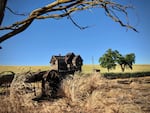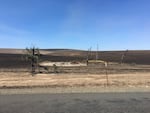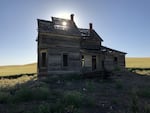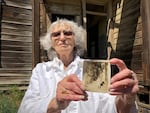For almost 80 years, the Charles E. Nelson House stood abandoned and alone, tucked into a hollow on the high plains of Oregon. A clapboard farmhouse, sun-bleached, empty, leaning against the wind. It was widely considered the most photographed abandoned farmstead in Oregon.
Now, it's gone.
The iconic house near The Dalles burned to the ground in the Substation Fire, which had burned more than 36,000 acres and left one person dead as of this story's publishing on Wednesday.
"[The house] takes the viewer by surprise when it comes in to view," wrote Theresa Petterson, of Dufur, "tattered to the point of collapse, but still somehow it remains standing. Even in its precarious position, it is still stately. Out of place in the middle of a wheat field but yet it belongs, as a testament to the past."

The Nelson House in recent years became incredibly popular with photographers.
Ian McCluskey / OPB
In recent years, the Nelson House gained popularity with photographers and was shared widely on social media.
"So many of us cut our teeth on photographing this house," said photographer Danielle Denham. "It was one that inspired me to start exploring."
Denham visited many times over the years to photograph the Nelson House. She returned to document it again hours after the fire.
"It's devastating to come around the turn in the road, seeing the smoking scorched land," she said.

The site of the Charles Nelson House, which was destroyed in the Substation Fire.
Molly Solomon / OPB
With the greater exposure, incidents of trespassing at the house increased in recent years.

Sun peeks through the roof of the Charles Nelson House.
Ian McCluskey / OPB
The clapboard Queen Anne Victorian dated back to the late 1800s.
The home was named for Charles Nelson, the last occupant of the old farmhouse. He and his wife, Orma, moved into it in 1927 and raised two daughters. In 1949, they left the house and it has remained empty since.

Inside the Nelson House before it burned.
Ian McCluskey / OPB
Ellen Simmons grew up visiting her uncle Charles and aunt Orma at the home when it was still a working farm. She recalled the parlor stove that heated the house, the wood stove where meals were cooked and hand-stitched quilts on the beds.
Simmons, 90, has a photo of herself standing on the front porch in 1928.
With only the rusted wagon wheels and the metal windmill tower remaining, Northwest photographers have lost one of their favorite locations, and Oregon has lost an icon of its frontier past.
"I'm sure glad I got to see it one last time," Simmons said.

Ninety-year-old Ellen Simmons holds photo of herself standing on the porch of the Nelson House in 1929.
Ian McCluskey / OPB

